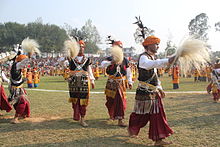The dhoti, also known as veshti,[1] mardani, dhotar, jaiñboh or panchey, is a garment worn around the waist and fastened between the legs to resemble trousers. It is usually worn loose.[2][3][4] It is most popular in India and Nepal.[citation needed] The dhoti is a lower garment forming part of ethnic wear for men in the Indian subcontinent.[5] The dhoti is fashioned out of a rectangular piece of unstitched cloth, usually around 4.5 metres (15 ft) long, wrapped around the waist and the legs and knotted, either in the front or the back.

The dhoti is considered the male counterpart of the saari worn by females to religious and secular ceremonies (functions).[6] A pitambar is a yellow silk dhoti worn on auspicious occasions.[7][8] Dhoti pants are a ready to wear version, popular among women and typical of children.[9][10][11]

Etymology

It is also referred to as "dhautra" (IPA: /dʱɑwtɽɐ/) in Sanskrit, which means rope or cord. The dhoti evolved from the ancient antriya which was passed through the legs, tucked at the back and covered the legs loosely, then flowed into long pleats at front of the legs, the same way it is worn today as formal dhoti.[12]: 130 While a casual and short dhoti wraps around both legs firmly, in this style the back side of the dhoti is pulled to the front and tucked at the waist, before tucking the two loose ends at back, creating firmly fitted trouser-like dhoti that wraps around both legs. This style is more commonly worn by farmers and martial artists.[13][14]
Names and styles


The garment is known by various names based on language, such as:
| Native script | Transliteration | Language or region |
|---|---|---|
| চুৰিয়া, ধুতি | Suriya, Dhuti | Assamese |
| ধুতি | Dhuti | Bengali |
| ધૉતિયુ | Dhotiyu | Gujarati |
| धोती | Dhotī | Hindi, Maithili, Nepali and Pali |
| मर्दानी | Mardānī | Hindi |
| ಧೋತ್ರ ಕಚ್ಚೆ ಪಂಚೆ | Dhotra Kachche Panche | Kannada |
| धोंतर, आंगोस्तर, आड नेसचे, पुडवे | Dhontara, Āṅgostara, Āḍa nesace puḍave | Konkani |
| മുണ്ട് | Muṇṭ | Malayalam |
| धोतर | Dhotara a | Marathi |
| ଧୋତି | Dhotī | Odia |
| ਚਾਦਰਾ | Chaadra | Punjabi |
| வேட்டி | Vaetti | Tamil |
| పంచె, ధోవతి | Pañce, Dhōvati | Telugu |
| دھوتی | Dhoti | Urdu |
| a In Marathi, a dhotar is not the same as a pancha (plural panche). While the former is worn around the waist, the latter is normally a towel used after bathing (compare below). | ||
Custom and usage
The pancha is worn by many conservative Jain men when they visit Derasars or Basadis for puja; unstitched clothing is believed by some Jains to be "less permeable to pollution" and therefore more appropriate for religious rituals than other garments.[15] They also wear a loose and unstitched cloth, shorter than the pancha on top.

Hare Krishna, known for its distinctive dress code, prompts Western adherents to wear pancha, usually of saffron or white cloth folded in the traditional Bengali style. Maharishi Mahesh Yogi was known for wearing a white silk dhoti.[16]
The dhoti has been ethnically worn by farmers, pehlwano (wrestlers) and shepherds (grazers) of the Sikhs in the Punjab region; it was discouraged during the Punjab Subah Movement, owing it to the inter-communal tensions prevalent at the time.[17][18] The dhothi was also worn by South Canarese Christian men to their pre-nup ceremonies, Church weddings and receptions until the 1960s, when they fell out of favour; since then grooms have been styling the black suit and tie instead.[19]

There's a distinction between the lungi, a similar garment often worn by people at their homes, as it is more casual and comfortable, dhoti is sometimes even worn by secular politicians.[20]

At the height of the Indian Independence Movement, weaving was a symbol of the Swadeshi Movement. In 1921, the famed M K Gandhi himself championed only the dhoti often topless and without a kurta, to promote and identify with the weaves and handicrafts, produced by the rural and the poor of his homeland.[21][22][23]
See also
References


